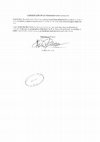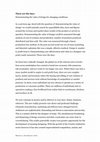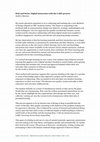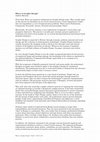Papers by Andrew T Barnum

Re-defining creativity within the creative industries discourse: With particular reference to its sustainability, 2011
Abstract:
Starting from a practitioner's standpoint, this study investigates creativity as a sys... more Abstract:
Starting from a practitioner's standpoint, this study investigates creativity as a system in which individual talent, desire and ambition operate. In the context of sustaining these motivations, personally and commercially, I examine the creative industries discourse as an 'organising principle' and an 'historical evolution' of a system named to provide relevant frameworks and guidelines for the future sustenance of practitioners and patrons.
This thesis has arisen from an investigation into the changed conditions outlined within the creative industries discourse, an argument, for a potential re-definition of'creativity' that better fits the conditions generated by the emerging knowledge economy. The study is viewed through the lens of my own 33 years of practice as an Artist, Designer and Musician.
The study considers the intrinsic struggle of free individuals to sustain their passion to generate deeper meaning within an industrialised system of livelihood initially created through a government policy initiative. The aim is to explain the individual practitioners' relationship to a system that contains numerous and complex tensions. My aim is to offer an understanding of an industrialised system that has responded to a shift in conditions in which individual talent and aspiration are 'forced' to function.
As part of our re-definition of creativity, we should be working to convert the prevalent 'precarious state' of creative practice into a more 'secure' livelihood and give greater recognition to the creative industries idea as a more consistent, broadly accepted cultural and economic imperative. Any re-definition of creativity needs to help reveal most creative practice as an under-recognised struggle with inconsistent tangible income as a reward for a life of passion and faith. Practitioners deeply believe in the value of their
commitment to this very human work and their decision to choose a decidedly risky life-pathway.
For this study, in considering a re-definition of creativity, with particular reference to its sustainability, within the context of the creative industries discourse, I've investigated a range of conditions, definitions and 'realities' that affirm the need for a re-definition of creativity and its distribution in today's so-ca11ed 'creative age' and the emergent creative economy.
Australian Cultural Policy Submission , 2022
A new Australian cultural policy will have the power to ask the right questions to undo the syste... more A new Australian cultural policy will have the power to ask the right questions to undo the systemic cultural absence of our contested Australian multi-cultural identity. A new Australian Cultural Policy provides an opportunity to re-assess the symbolic and practical inclusion of the voices of our ‘under-loved’ creative arts back into our own fragmented, externally owned, media mainstream. I believe that Australia’s lazy cultural systems (Cringe, Silence, Tall poppy, She’ll be right, No worries etc) are the root cause of our own determined self-exclusion from legitimacy. A new cultural policy has the promise to once and for all locate an unshakeable national self-respect for our own creative voices, and to legitimise our Australian identity.
ToTheHeart.com.au, 2021
Many Australians still maintain an embedded cultural reticence towards our First Nations People's... more Many Australians still maintain an embedded cultural reticence towards our First Nations People's desire to be recognised in the Australian Constitution. The Voice of the Uluru Statement of the Heart is a generous gift of collective self-recognition, and co-citizenship for all Australians to embrace our shared future. The result must be a victorious referendum to complete the Australian Constitution by enshrining The Voice for the ages through its profoundly human rejection of systemic powerlessness.
Parliament of Australia website, 2020
We are at a crucial turning point in this country, and every Australian has some extra learning, ... more We are at a crucial turning point in this country, and every Australian has some extra learning, and growing to do to meet the ongoing challenges. We all have to ask ourselves - how do we grow more opportunity through an expanded national imagining of possibility, versus a consistently reduced and overly pragmatic and politically divisive definition of what national innovation means.
BBetween6_Journal of Billy Blue College of Design, 2013
"In considering this increasingly shunting, quiksilver thing called Creative
Education, I’d like ... more "In considering this increasingly shunting, quiksilver thing called Creative
Education, I’d like to reflect on the spaces where Creativity and Learning are
percolating in this crowding, Creative Age."
BBetween4_The journal of Billy Blue College of Design, 2011
“What makes the reef so inventive is not the struggle between the organisms but the way they have... more “What makes the reef so inventive is not the struggle between the organisms but the way they have learned to collaborate"

BBetween3_Journal of Billy Blue College of Design, 2010
These are the days Demonstrating the value of design for changing conditions. In a previous age, ... more These are the days Demonstrating the value of design for changing conditions. In a previous age, faced with the question of 'demonstrating the value of design' we would instantly search for quantifiable data, facts and figures around the revenue and market share results of the product or service in question. Demonstrating the value of design would be measured through analysis of cost of creation and production, number of products produced, distributed and then sold. The value was measured through a linear, production line method. In the post second world war era of mass-marketing and futuristic optimism this was a simple, effective method. Design it, market it, profit from it. Demonstrating your effectiveness and value as a designer was pretty easily measured. Those were the days. So times have radically changed, the global era of the internet and a twenty-four-seven marketplace has created a brand new economy with numerous sub-economies. And as I write it's no longer very new. Where there was once a mass-market model to aspire to and profit from, there are now complex layers, niches and locations where the buying and selling of vast volumes of products and services exist without knowledge of competition or market pressure. In short, every individual can now choose to operate as a variety of production or consumer profiles. There are millions of individuals and cooperatives making a fine livelihood from online hubs in warehouses, kitchens and nowhere at all. We now consume in person and by delivery to your door. Home, business, wherever. The new reality presents vast choice and profound challenge. Channels of production, marketing and delivery have changed forever. Audiences are sophisticated, demanding and drawn to innovation and novelty. This is a seismic shift for the designer of today. The simultaneous broadening and deepening of design scenarios and their constraints can come close to overwhelming. This reality potentially creates even greater opportunity for the development of amazing designing. With the growth of the Creative Industries sector however it has also created unprecedented competition, anxiety and and above all need for re-education.
Ligature Journal, 2018
Ligature Journal 06 2018
By now, we've all been consumed by our digital curiosity and habit, dow... more Ligature Journal 06 2018
By now, we've all been consumed by our digital curiosity and habit, downloaded all the apps, argued on social media ad nauseam, surrendered democracy, and slowly but steadily moved on from any previous analogue world where we leafed through experience, and suspended our need to have everything we desired.
In this submission we the Australian Association of Musicians (AM) are considering the reasons wh... more In this submission we the Australian Association of Musicians (AM) are considering the reasons why our Association should support
these beliefs as central to our strategy to re-invigorate The Australian music Industry, which is both a cultural and commercial Australian enterprise, locally and globally. This submission considers the factors that will grow and sustain our uniquely Australian Music Industry, as a proud Cultural and Creative Industry, and in doing so, confirm our sense of self as Australian musical entrepreneurs, our desire to feel we belong here in
our birthplace as Australian artists, producers and copyright holders, and can sustain livelihood and opportunity at home, as productive members of the field of cultural production in Australia.
I’d like to propose a different perspective to re-purpose the fragile thing we know as ‘The Music... more I’d like to propose a different perspective to re-purpose the fragile thing we know as ‘The Music Industry’ in Australia. In approaching the problem of sustaining a music/arts career livelihood in Australia and growing opportunity, I’d like to step back from the usual reactive, quick fix-it mindset, and offer what I’ve found in my PhD research as a responsive approach to the underlying causes of our current cultural crisis.

My recent education experience is of co-authoring and teaching into a new Bachelor of Design (Dig... more My recent education experience is of co-authoring and teaching into a new Bachelor of Design (Digital) at JMC Academy Sydney. The degree is responding to the profound shift in communication design user behavior, strategic methodologies and media techniques. Our new approach has quickly revealed that learners, course content and the educators relationship with these digital intuits have resulted in excellent engagement, retention and relevant and surprising design outcomes. My key observation is that the learning materials and their interaction can no longer be held under authority or permission by institutions and their libraries, or even their course advisors as the sole source of their learning. Due to the vast knowledge, interaction and contact available via the internet and its related experience, students now have the opportunity to reach around, above and below the linear learning path set out, and access shared free content and interactions that points to a revised and expanded role for the overarching pedagogy. I've noticed through teaching our new course, that students share behavior towards learning that appears to be a digital intuition founded on search habits, and a gaming relationship that includes risk, reward and approval founded within their own networks with a measure of relevance in learning for the world in which we now live. Their method and experience appears like a person standing at the edge of a vast lake or ocean of knowledge input as they approach a project and its tentative first responses of unknowing. They are poised to dive into their own intuitive learning experience on their own terms. The educator now guides, curates and adds to their experience and outcomes collaboratively. The student embarks on a series of simultaneous actions as they survey the game (brief) they are commencing. They scan the written assessment instructions set out by the course, highlight the key requirements, then plunge into their own, and collective 'casting out' into the various levels of immersion within their lake of potential learning. This process appears to be an iterative mix of diving as deep as possible into the center of the lake, then quickly retreating to the shallows of the problem soaking wet for approval or direction. This is followed by a series of forward and backward diving entries and exits that yield a series of collected depths of understanding to achieve a useful hold on the problem and the ensuing ideas. I call our immersive process LAKE: Learning Access Keeps Expanding. This game of orbiting in and out of a mix of curated materials, approvals, permissions and user testing is far from linear, and happens quickly and automatically. No matter their level in the course. The process of discovery, visualization, writing, testing and prototyping is akin to the human-centered design approach of discover-ideate
Open Manifesto 7. A consideration of our changing role as designers within the notion of 'enlight... more Open Manifesto 7. A consideration of our changing role as designers within the notion of 'enlightened self-interest' the shifting contexts of the connected age, design-thinking, creative industry and social re-engineering as result.
Written for Billy Blue's Journal BBetween#7, this paper promotes an awareness of the growing anxi... more Written for Billy Blue's Journal BBetween#7, this paper promotes an awareness of the growing anxiety of our society consumed by the technological marvel of the connected age. This is explained through Bruce Sterling's grand narrative 'Dark Euphoria' as a fitting metaphor for these times and their semi-chronic condition.

Open Manifesto 3, Nov 13, 2006
Where to graphic design?
An essay by A.B. (Australia)
{13th of November 2006}
There are n... more Where to graphic design?
An essay by A.B. (Australia)
{13th of November 2006}
There are numerous definitions for Graphic Design today. Broadly, there is agreement on the practice (or discipline) being an activity based around a visual organisation of ideas that are responding to a set of ‘communication problems’. These can be professional, commercial, non-profit, artistic, personal, and increasingly—‘other’.
Historically, the activity requires a rare combination of expressive visual talent and pragmatic objectivity. The practice is usually part strategic and part application of techniques that derive from ‘graphic art’ as evolved through Industrial and Artisan based printing techniques.
Graphic Design is connected to History through economic, political, personal and social change, and the evolution of communication technologies. It continues to visually document the changing world in which we live, through visual and textual artifacts of the highest and lowest of cultures. Wherever the economy of mankind operates you will find evidence of Graphic Design—on paper, electronic and out-door media.
So, even though Graphic Design is now the widely recognised descriptor for the practice of commercial image and message making, the broadening of the context as expressed by the updated definition ‘Communication Design’ again finds us at a moment of re-definition for the practice.
With the acceptance of digitally generated ‘artwork’ and screen media, the professional Designer no longer owns exclusive rights to the making of design for commercial distribution. The professional now has to work much harder to demonstrate the relevance and potential impact of their work to sustain a career.
(The rest of this article is available, in print, in Open Manifesto #3)
Conference Presentations by Andrew T Barnum

There is a growing number of Australians, both young and old, who are disclosing a proud affectio... more There is a growing number of Australians, both young and old, who are disclosing a proud affection for their nation, and its experience, through song. This study is exploring, through participant interviews, and the lens of Australian song, an emergent connection of our songwriters to local narratives, multi-cultural language, and place. These expressions are becoming an acceptable declaration of the grain of the Australian voice (Barthes). Increasingly, the energy of songwriters in this nation today exists most authentically at the independent level. The Australian songwriter's habitus requires the disposition that their independent production may never cross the commercial divide to be heard or seen via local media platforms. This position produces a defiant otherness in the Australian songwriter, a proud dedication to writing and performing songs that capture their local experience, in their own voice. This is a determined stance, where songwriters are purposefully rejecting commercial criteria to produce songs that wholeheartedly locate a true telling of their Australian reality. Expressed by local songwriters from a relevant mix of gender, musical genre and professional level, this study aims to reveal the tensions that exist between the Australian grain of the voice, the acceptance and recognition of the vital otherness of our songwriter's production, and the artefacts of our nation-ness they vitally produce. In this age of digital music, the growing chorus of these positions is in opposition to previously existing cultural systems of recognition and constitutes a renewed desire to advocate for the currency of authentic Australian identity in song. Biography Andrew Barnum is a designer, educator and published singer-songwriter. He has sustained a portfolio career as practitioner, educator and theorist. He completed a Masters by Research from UTS:FASS (2010) focused on sustaining practice in the Creative Industry context. He has released five independent solo albums of locally inspired songs.
Thesis Chapters by Andrew T Barnum

Re-defining creativity, with particular reference to its sustainability, within the context of the creative industries discourse, 2012
Starting from a practitioner's standpoint, this study investigates creativity as a system in whic... more Starting from a practitioner's standpoint, this study investigates creativity as a system in which individual talent, desire and ambition operate. In the context of sustaining these motivations, personally and Contents Abstract 1 Chapter 1. Introduction 5 Creative industries beginnings 7 The 13 segments of the creative industries sector 8 Creativity industries as a response to changing conditions 9 Key questions arising from creative industries discourse 10 Chapter 2. Definitions of creativity: Creation, divinity, philosophy, problem-solving 12 Creation 13 Early distinctions 14 Evolution 15 Philosophy 16 Divine creators, production and problem-posing 17 Aesthetics, struggle and conniving 18 The creative process explained 20 Chapter 3. Mainstreaming culture: Arts to industry 23 Creative industries: A product not of industry but of history 23 New conditions 23 Civic humanism 24 Creative industries: A new personal identity 25

Uploads
Papers by Andrew T Barnum
Starting from a practitioner's standpoint, this study investigates creativity as a system in which individual talent, desire and ambition operate. In the context of sustaining these motivations, personally and commercially, I examine the creative industries discourse as an 'organising principle' and an 'historical evolution' of a system named to provide relevant frameworks and guidelines for the future sustenance of practitioners and patrons.
This thesis has arisen from an investigation into the changed conditions outlined within the creative industries discourse, an argument, for a potential re-definition of'creativity' that better fits the conditions generated by the emerging knowledge economy. The study is viewed through the lens of my own 33 years of practice as an Artist, Designer and Musician.
The study considers the intrinsic struggle of free individuals to sustain their passion to generate deeper meaning within an industrialised system of livelihood initially created through a government policy initiative. The aim is to explain the individual practitioners' relationship to a system that contains numerous and complex tensions. My aim is to offer an understanding of an industrialised system that has responded to a shift in conditions in which individual talent and aspiration are 'forced' to function.
As part of our re-definition of creativity, we should be working to convert the prevalent 'precarious state' of creative practice into a more 'secure' livelihood and give greater recognition to the creative industries idea as a more consistent, broadly accepted cultural and economic imperative. Any re-definition of creativity needs to help reveal most creative practice as an under-recognised struggle with inconsistent tangible income as a reward for a life of passion and faith. Practitioners deeply believe in the value of their
commitment to this very human work and their decision to choose a decidedly risky life-pathway.
For this study, in considering a re-definition of creativity, with particular reference to its sustainability, within the context of the creative industries discourse, I've investigated a range of conditions, definitions and 'realities' that affirm the need for a re-definition of creativity and its distribution in today's so-ca11ed 'creative age' and the emergent creative economy.
Education, I’d like to reflect on the spaces where Creativity and Learning are
percolating in this crowding, Creative Age."
By now, we've all been consumed by our digital curiosity and habit, downloaded all the apps, argued on social media ad nauseam, surrendered democracy, and slowly but steadily moved on from any previous analogue world where we leafed through experience, and suspended our need to have everything we desired.
these beliefs as central to our strategy to re-invigorate The Australian music Industry, which is both a cultural and commercial Australian enterprise, locally and globally. This submission considers the factors that will grow and sustain our uniquely Australian Music Industry, as a proud Cultural and Creative Industry, and in doing so, confirm our sense of self as Australian musical entrepreneurs, our desire to feel we belong here in
our birthplace as Australian artists, producers and copyright holders, and can sustain livelihood and opportunity at home, as productive members of the field of cultural production in Australia.
An essay by A.B. (Australia)
{13th of November 2006}
There are numerous definitions for Graphic Design today. Broadly, there is agreement on the practice (or discipline) being an activity based around a visual organisation of ideas that are responding to a set of ‘communication problems’. These can be professional, commercial, non-profit, artistic, personal, and increasingly—‘other’.
Historically, the activity requires a rare combination of expressive visual talent and pragmatic objectivity. The practice is usually part strategic and part application of techniques that derive from ‘graphic art’ as evolved through Industrial and Artisan based printing techniques.
Graphic Design is connected to History through economic, political, personal and social change, and the evolution of communication technologies. It continues to visually document the changing world in which we live, through visual and textual artifacts of the highest and lowest of cultures. Wherever the economy of mankind operates you will find evidence of Graphic Design—on paper, electronic and out-door media.
So, even though Graphic Design is now the widely recognised descriptor for the practice of commercial image and message making, the broadening of the context as expressed by the updated definition ‘Communication Design’ again finds us at a moment of re-definition for the practice.
With the acceptance of digitally generated ‘artwork’ and screen media, the professional Designer no longer owns exclusive rights to the making of design for commercial distribution. The professional now has to work much harder to demonstrate the relevance and potential impact of their work to sustain a career.
(The rest of this article is available, in print, in Open Manifesto #3)
Conference Presentations by Andrew T Barnum
Thesis Chapters by Andrew T Barnum
Starting from a practitioner's standpoint, this study investigates creativity as a system in which individual talent, desire and ambition operate. In the context of sustaining these motivations, personally and commercially, I examine the creative industries discourse as an 'organising principle' and an 'historical evolution' of a system named to provide relevant frameworks and guidelines for the future sustenance of practitioners and patrons.
This thesis has arisen from an investigation into the changed conditions outlined within the creative industries discourse, an argument, for a potential re-definition of'creativity' that better fits the conditions generated by the emerging knowledge economy. The study is viewed through the lens of my own 33 years of practice as an Artist, Designer and Musician.
The study considers the intrinsic struggle of free individuals to sustain their passion to generate deeper meaning within an industrialised system of livelihood initially created through a government policy initiative. The aim is to explain the individual practitioners' relationship to a system that contains numerous and complex tensions. My aim is to offer an understanding of an industrialised system that has responded to a shift in conditions in which individual talent and aspiration are 'forced' to function.
As part of our re-definition of creativity, we should be working to convert the prevalent 'precarious state' of creative practice into a more 'secure' livelihood and give greater recognition to the creative industries idea as a more consistent, broadly accepted cultural and economic imperative. Any re-definition of creativity needs to help reveal most creative practice as an under-recognised struggle with inconsistent tangible income as a reward for a life of passion and faith. Practitioners deeply believe in the value of their
commitment to this very human work and their decision to choose a decidedly risky life-pathway.
For this study, in considering a re-definition of creativity, with particular reference to its sustainability, within the context of the creative industries discourse, I've investigated a range of conditions, definitions and 'realities' that affirm the need for a re-definition of creativity and its distribution in today's so-ca11ed 'creative age' and the emergent creative economy.
Education, I’d like to reflect on the spaces where Creativity and Learning are
percolating in this crowding, Creative Age."
By now, we've all been consumed by our digital curiosity and habit, downloaded all the apps, argued on social media ad nauseam, surrendered democracy, and slowly but steadily moved on from any previous analogue world where we leafed through experience, and suspended our need to have everything we desired.
these beliefs as central to our strategy to re-invigorate The Australian music Industry, which is both a cultural and commercial Australian enterprise, locally and globally. This submission considers the factors that will grow and sustain our uniquely Australian Music Industry, as a proud Cultural and Creative Industry, and in doing so, confirm our sense of self as Australian musical entrepreneurs, our desire to feel we belong here in
our birthplace as Australian artists, producers and copyright holders, and can sustain livelihood and opportunity at home, as productive members of the field of cultural production in Australia.
An essay by A.B. (Australia)
{13th of November 2006}
There are numerous definitions for Graphic Design today. Broadly, there is agreement on the practice (or discipline) being an activity based around a visual organisation of ideas that are responding to a set of ‘communication problems’. These can be professional, commercial, non-profit, artistic, personal, and increasingly—‘other’.
Historically, the activity requires a rare combination of expressive visual talent and pragmatic objectivity. The practice is usually part strategic and part application of techniques that derive from ‘graphic art’ as evolved through Industrial and Artisan based printing techniques.
Graphic Design is connected to History through economic, political, personal and social change, and the evolution of communication technologies. It continues to visually document the changing world in which we live, through visual and textual artifacts of the highest and lowest of cultures. Wherever the economy of mankind operates you will find evidence of Graphic Design—on paper, electronic and out-door media.
So, even though Graphic Design is now the widely recognised descriptor for the practice of commercial image and message making, the broadening of the context as expressed by the updated definition ‘Communication Design’ again finds us at a moment of re-definition for the practice.
With the acceptance of digitally generated ‘artwork’ and screen media, the professional Designer no longer owns exclusive rights to the making of design for commercial distribution. The professional now has to work much harder to demonstrate the relevance and potential impact of their work to sustain a career.
(The rest of this article is available, in print, in Open Manifesto #3)